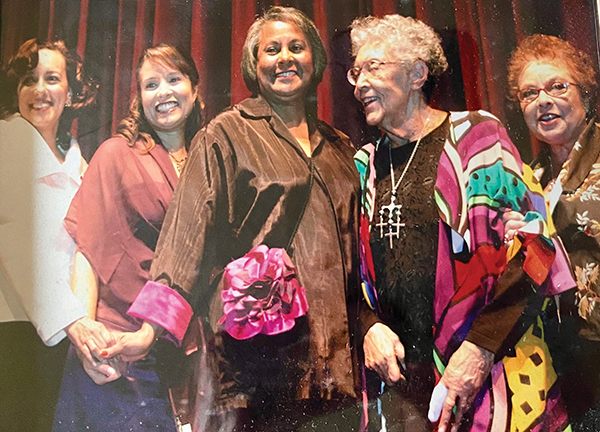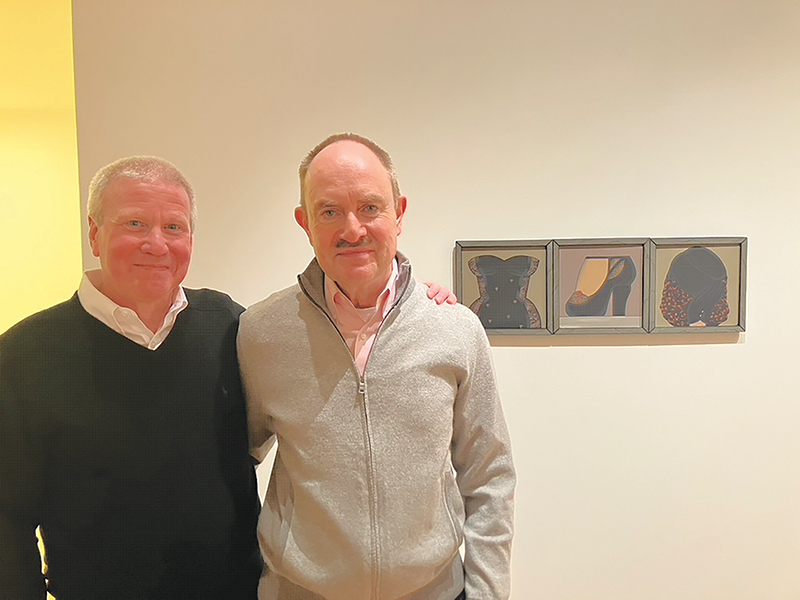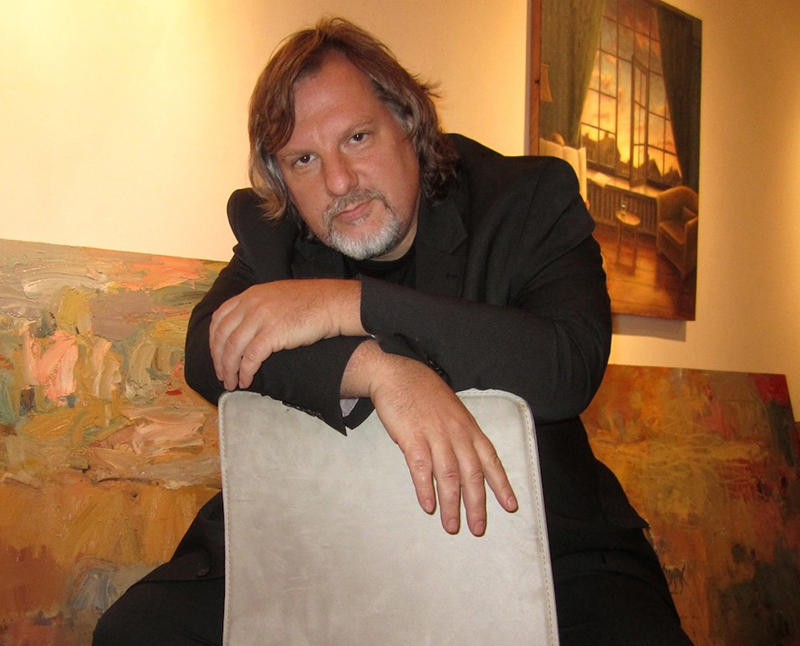Artist Insights: Judy Ledgerwood

BY LAURA M. METTAM
Judy Ledgerwood’s bold use of color and pattern transforms the spaces in which her art exists. She establishes a dichotomy between precision and abstraction, order and chaos, the vividly decorative and the subtly conceptual. Ledgerwood has received numerous awards from prestigious arts organizations, including the National Endowment for the Arts and Artadia. Her work is held in international private collections as well as in many of the nation’s top art museums, such as the Art Institute of Chicago and the Metropolitan Museum of Art.
Currently a Professor and the Director of Graduate Studies in the Department of Art Theory and Practice at Northwestern University, Ledgerwood lives and works in Chicago. She is represented by Chicago’s Rhona Hoffman Gallery, as well as by several other international galleries in New York, Los Angeles and Houston, Germany, Switzerland and Austria.
Top image: Judy Ledgerwood, Chromatic Patterns for the Graham Foundation, 2014, Graham Foundation, Chicago, IL

LM: Do you remember when your interest in art first began?
JL: My mother was in graduate school for education at Indiana State University. In her early childhood education class, she learned that kids would be more creative if they weren’t given coloring books but instead, made their own pictures. This early encouragement reached a crisis when I was seven and lost a coloring contest to a girl named Lori. I was disappointed that her Cinderella picture, neatly colored within the lines, was selected over mine, which I clearly thought was more artistic. I’ve been seeking attention for my art-making ever since.
• You earned your BFA from The Art Academy of Cincinnati and your MFA from SAIC. Can you provide a brief background about where you grew up and then elaborate on your decision to study art through the graduate level? Any comments on your experience as an art student?
I grew up in a tiny farming community in Indiana. I identified as an artist at an early age, so I understood that artists need to be a part of a larger community. I chose what I thought was the surest path to my success through education. I had studied the biographies of other artists whom I admired, and this was the path that they followed so I emulated them.
I met my husband, Tony Tasset, in undergraduate school. He shared my ambition of becoming an artist and together we still make a strong team. We grew up together sharing successes and failures in a very difficult field. I’m his biggest fan and vice versa. It’s invaluable to have a person who believes in you and understands what you do.
At SAIC, for the first time I met artists who were better than me. That’s the thing about moving from a small town to a larger one. The challenge to keep up was just the kick in the pants that I needed. That and a fear of truly becoming a starving artist pushed me to focus on what I needed to do to become a professional artist.

• Were you always interested in teaching? What path led you to your current role as Professor and Director of Graduate Studies in the Department of Art Theory and Practice at Northwestern University?
I didn’t teach until I was out of grad school for almost a decade. I got lonely working in my studio and I found that socially, artists wanted to network more than discuss art. I wanted to discuss the big questions; I missed that about school. I started teaching one class at SAIC, then soon after I began full time at Northwestern. Our students rarely self-identify as artists, but most go on to contribute to society. I am in the perfect position to proselytize for art. Many high schools no longer offer courses in art, but I think it’s the best way to learn critical thinking. There are no right choices when making art, only ones that work. Learning how to determine a working method and the criteria for judgment is something that I’ve only recently gotten good at. The icing on the cake of my job is working with graduate students. Northwestern fully supports the MFA candidates, so we get the cream of the crop in our graduate program since it is so competitive for top candidates.
• How do you think today’s art students and art schools differ from when you were in school? What has changed? Where are things headed?
The big change has been in the softening of disciplinary boundaries. Young people no longer say, “I’m a painter.” They say, “I’m an artist,” or maybe even something like, “I make things.” Art school in the 21st century focuses to a lesser degree on the artist as an individual author, and more on community solutions to aesthetic, political or even practical problems - a reflection of how the art world really is now. Of course some fields like painting will not change much pedagogically. And hopefully education can do more than train worker bees for artists like Jeff Koons.

• Your work is vivid and energizing. Repetitive patterns are controlled but not exact. They are precise yet loose. When viewing the larger installations of repeat patterns, I think about the performative aspect of creating the work and how the physical act of painting is also repetitive and controlled. I find the thought of creating these wall paintings - such a time consuming, perhaps meditative process - as an almost comforting, contemplative change of pace from our culture’s digital age need for instant results. Can you comment on your work process for both large installations and smaller works on canvas?
I think about creating experiences that must be seen first person - whether work on canvas or large-scale installations painted on the wall. Patterns suggest regular continuity, but life is not like that, even with many repetitive gestures that make up a day, like morning coffee or showering. Each moment is unique if you’re aware.
I try to make paintings that not only breathe in the after-image created by visual color interactions that flicker visualy, but allow the performative act of painting to create a sense of time, especially through repetitive patterns. The drips suggest real time. I experience time as elastic. Moments spent on hold with the utility company are endless; moments spent with your young child pass in a heartbeat. I think my work functions well if the viewer’s experience brings about a greater self-awareness. This is not so different from the aims of all abstract painting.

• I love the transformative environments that your installations and immense wall paintings create. The installations have the power to alter familiar spaces as seen in your recent Chromatic Patterns for the Graham Foundation, and Chromatic Patterns for the Smart Museum, among many other pieces you’ve done in the past. Can you talk about your use of such vivid colors and repeat patterns, and how the scale and content of your work has evolved over the years? Are you experimenting with any new methods or materials?
I have shifted from a palette based on a response to decorative color in architecture that commented on Modernisms’ failures, to work that creates cast color or uses color interaction to leak out from the surface of the painting into the space in front of the canvas, the space where the viewer is. Each era develops a new model for describing space, and space reflects the age that produces those responses. Think of the Cartesian model of space developed during the Renaissance as a model of rationalism as just one example. When I started my career in the artworld of the late 80s at the moment of the first art boom, the thing that seemed most urgent to address was the increasing power of images circulating as reproductions. There are paintings that look good reproduced that are generally not very satisfying to look at in person. For me, an art experience is between a viewer and a work of art, not between a viewer and an electronic device. It’s even more of an issue now, so I still stand by my desires to make painting a first person experience.
I started using enormous scale early in my career. Then, as now, I want to create immersive environments - to make paintings that act like architecture. Once I felt that the scale was becoming habitual, I had to learn to make smaller paintings that were effective. I discovered that making smaller paintings scaled to the human body and installed to emphasize that relationship helped to make a direct connection to the viewer. I still make a lot of 15 x 15" paintings to try out a new idea on a manageable scale.
I tried encaustic painting recently. I wanted to see what happened when color was not contained within the edges of a shape and edges between figure and ground were more erratic. I like the object quality of these kinds of paintings, but the encaustic is limited because it has to be done on panels, which get too heavy at large scale. So now I’m trying to achieve a similar goal with more familiar painting materials and techniques.

• Is there a way in which your work is displayed that you feel it has the potential to have the most impact on the viewer? For example, how might a smaller painting on canvas compare to a wall installation compared to something even larger like your 2014 collaboration with EXPO Chicago and The Beaches of Fort Myers & Sanibel that resulted in a very public display of your artwork around Chicago during EXPO. Any comments on your experience with this particular public art project or others you may have been involved with in the past?
For me the reason to make paintings is to address a viewer. I am always aware of the viewer when I make installation choices. Small paintings are hung to correspond to the viewers’ head, and the size of the shapes is at human scale, often in response to architecture, which is also built for bodies. The EXPO Chicago and The Beaches of Fort Myers & Sanibel project was an opportunity to make a work outside a gallery or institution, which was new for me. Although one response to spending time at Rauschenberg’s studio in Captiva Island might have resulted in a typical Ledgerwood painting in a palette inspired by the light of Florida, I instead made work inspired by the light and space. For me the most profound experience of the place was the vast expanse of sand, sea and sky, and just as important this was conceived of as a project for everyone, not just your typical art going public.
I wanted to work in a genre that most people understand, and landscape seemed appropriate to the site of presentation. I also liked the contrast between horizontal landscape in the billboards and their placement in an urban environment. These landscapes harkened back to the kind of paintings that I made twenty years ago at the start of my career. I know that I was very privileged to have the Florida experience to respond to. I wanted to create an image in the city for those that didn’t have that experience, to share a little of what that experience was like for me with everyone who encountered the billboards.
• Do you have a favorite public art piece here in Chicago or elsewhere?
I love the Picasso in Daley Square and the Dubuffet on the corner of the State of Illinois building.
• Who are some of your favorite artists – older influences, or currently working artists?
I grew up visiting the impressionist collection at the Art Institute of Chicago. I think that I learned color theory in those galleries. So I am indebted to Monet as much as I hate to admit it. Matisse, Blinky Palermo, Mary Heilmann, Harriet Korman, Pamela Fraser & André Butzer are just a few favorite artists that come to mind.
• Between your practice, your husband also being a prominent artist, and your teaching, do you ever reach a saturation point when it comes to art consumption? When you need to tune out, so to speak, what’s a favorite non-art interest of yours?
We are busy just trying to keep up, so there is not enough down time, which I hope to address - as soon as I have time! Tony is very good at cooking, and I wish I could spend more time gardening. My garden it pretty Darwinian, but I grow mostly perennials, a few vegetables, and I have a tiny cutting garden every summer.

• You mentioned that you’d be traveling to Lustenau soon for an exhibition. Can you describe this exhibition or project? Do you have any other plans coming up this summer or fall?
My show in Lustenau is with the same gallerist I have worked with in Europe since 2005, Wolfgang and Christa Hausler (Häusler Contemporary). They have galleries in Munich, Zurich and this newer one in Lustenau, Austria. My upcoming project for Lustenau is called Lose Loos in response to the influence of Adolf Loos on contemporary taste even though his seminal contribution, Ornament and Crime was written in 1908. Loos counseled against excessive pattern and advocated the use of only specific colors. His attitude was heavily influential for Le Corbusier, who of course is much admired. Chromophobia is shared by many people who think that colors limited to a few basics; black, white, ultramarine blue, grey, yellow ochre reflect a higher level of sophistication, with brighter colors relegated for children and people from ‘other’ cultures. Of course my work goes against all of this. Since the show is in Austria, it seems likely that many viewers will be aware of Loos position and see my work in opposition to his ideas.
Over the summer I plan to devote concentrated time to finishing a body of new work that I’ll show in Houston at Barbara Davis Gallery. I am also working toward a show in New York at Tracy Williams Ltd. for her new space on the lower East Side, and in January 2016 I have a sort of retrospective opening at the Kennedy Museum where I’ll make a wall painting installation, and show a selection of paintings and drawings. Also in September I was offered a five-day lectureship at the Academy of Fine Arts in Kolbermoor near Munich. I am interested in the global exchange of ideas.
• Would you share your thoughts on Chicago’s art community?
Chicago has more great artists than a city this size has any right to. Many do not get the recognition they deserve because it’s Chicago I suppose. The audience is not as large as one would think for a city of more than two and a half million. I’m lucky to have access to world-class museums here. Galleries are good - I wish more people supported them so that young artists didn’t feel so pressured to move to New York or Los Angeles to find the support they need.







